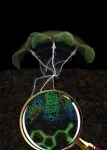(Press-News.org) Study: "Exploring the Association Between Student-College Match and Student Outcomes Over Time"
Author: Amanda M. Cook (Northwestern University)
This study will be presented today at the AERA 2021 Virtual Annual Meeting.
Session: Nuances and Challenges to Traditional Notions of College Success
Date/Time: Saturday, April 10, 10:40 a.m. - 12:10 p.m. ET
Main Findings:
Over the past 20 years, bachelor's degree completion rates for students who overmatch (i.e., attend colleges that may appear too academically selective for them) have improved substantially. Over the same time period, bachelor's degree completion rates for students who undermatch (i.e., attend colleges that appear too academically unselective for them) and match (i.e., attend colleges that appear to be good academic fits) have remained stable.
When the analysis is restricted to students with relatively high academic qualifications who begin their college careers at four-year institutions, matched and overmatched students' graduation rates improve over time, but undermatched students' do not.
Details:
A substantial body of research has demonstrated a link between student-college match and student outcomes, including graduation and post-college employment and earnings. Most studies on this topic find that students who undermatch are significantly less likely to complete a bachelor's degree than similar students who match or overmatch.
However, there has been little prior research on whether this association has changed over time. This study analyzed change over time in student outcomes by student-college match. It is the first to do so using data on a recent cohort of college students (i.e., students who started college after 2010).
The study used nationally representative data from the National Center for Education Statistics on three cohorts of first-time college students--those who began college in 1995, 2003, and 2011. The author looked at 25,020 individuals from these three samples of first-time college students for six years after their initial enrollment in college.
Undermatched students' graduation rates decreased slightly from 53 percent (1995 cohort) to 50 percent (2011 cohort). Matched students' graduation rates also decreased slightly, from 45 percent to 43 percent. By contrast, overmatched students' graduation rates increased substantially, from 55 percent to 65 percent.
When the sample is restricted to students with relatively high academic qualifications who start their college careers at four-year institutions, matched and overmatched students' graduation rates improve over time, but undermatched students' do not. For matched students from the 2011 cohort, the odds of graduating are 1.7 times higher than for their 1995 counterparts.
Similarly, for overmatched students from the 2011 cohort odds of graduating are 1.5 times higher than for their 1995 counterparts.
The study found that only a small portion of the improvement in overmatched students' graduation rates can be explained by changes over time in their academic qualifications, demographic characteristics, or college destinations.
"Undermatched students are consistently less likely to graduate, and overmatched students are consistently more likely to graduate, than matched students," said author Amanda M. Cook, a doctoral student at Northwestern University. "This reinforces prior research that, regardless of academic preparation and demographic characteristics, students' likelihood of graduating tends to improve when they attend more selective colleges."
"Recent pressure to improve graduation rates may have encouraged colleges to direct to direct more resources toward students who are struggling academically or students who enter colleges with lower academic qualifications than their same-college peers," said Cook. "If this is true, then overmatched students would be most likely to benefit. Matched students could also benefit from these policies if they were targeted widely enough."
"The study findings show that student-college match has become an increasingly important predictor of student success in recent years," Cook said. "This highlights the continued importance of programs and interventions to reduce the prevalence of undermatching, particularly for students from low-income, first-generation, and rural backgrounds."
INFORMATION:
To request a copy of the working paper, or to talk to the study author, please contact AERA Communications: Tony Pals, Director of Communications, tpals@aera.net, cell: (202) 288-9333; Tong Wu, Communications Associate, twu@aera.net, cell: (202) 957-3802
About AERA
The American Educational Research Association (AERA) is the largest national interdisciplinary research association devoted to the scientific study of education and learning. Founded in 1916, AERA advances knowledge about education, encourages scholarly inquiry related to education, and promotes the use of research to improve education and serve the public good. Find AERA on Facebook, Twitter, and Instagram.
Study: "Characterizing Remote Instruction Provided by Elementary School Teachers during School Closures due to COVID-19"
Authors: Michael Hebert (University of Nebraska-Lincoln), J. Marc Goodrich (University of Nebraska-Lincoln), Jessica M. Namkung (University of Nebraska-Lincoln)
This study will be presented today at the AERA 2021 Virtual Annual Meeting.
Session: Technology Supports and Experiences During the COVID-19 Pandemic
Date/Time: Saturday, April 10, 10:40 a.m. - 11:40 a.m. ET
Main Findings:
While teachers in spring 2020 felt that 60 percent of their students were prepared for the next grade level, in ...
Study: "Do Students in Gifted Programs Perform Better? Linking Gifted Program Participants to Achievement and Nonachievement Outcomes"
Authors: Christopher Redding (University of Florida), Jason A. Grissom (Vanderbilt University)
This study will be presented today at the AERA 2021 Virtual Annual Meeting.
Session: On the Road to Equity: Studies of the Impact and Influences of Education Policy
Date/Time: Saturday, April 10, 2:30 p.m. - 4:00 p.m. ET
Main Findings:
Participating in elementary school gifted programs is associated with reading and math achievement for the average student, ...
There are many questions surrounding the elementary particle neutrino, in particular regarding its mass. Physicists are also interested in whether besides the "classic" neutrinos there are variants such as the so-called sterile neutrinos. The KATRIN experiment has now succeeded in strongly narrowing the search for these elusive particles. The publication appeared recently in the journal Physical Review Letters.
Strictly speaking, the neutrino is not a singleparticle but rather comprises several species: the electron neutrino, the muon neutrino, and the tau neutrino. These particles are constantly transforming ...
A team of researchers from the Max Planck Institutes of Developmental Biology in Tübingen and the Max Planck Computing and Data Facility in Garching develops new search capabilities that will allow to compare the biochemical makeup of different species from across the tree of life. Its combination of accuracy and speed is hitherto unrivalled.
Humans share many sequences of nucleotides that make up our genes with other species - with pigs in particular, but also with mice and even bananas. Accordingly, some proteins in our bodies - strings of amino acids assembled according to the blueprint of the genes - can also be the same as (or similar to) some proteins in other species. These similarities might sometimes indicate that two species ...
A team of scientists at the Max Planck Institute for Developmental Biology in Tübingen and the University of Bayreuth have created a novel tool that provides a real-time visualization of the growth-regulating hormone auxin in living plant cells. This new biosensor enables them to observe spatial and temporal redistribution dynamics of the plant hormone, for example in conjunction with changing environmental conditions.
Auxin plays a central role in plant life. The hormone regulates various processes, from embryonic development to the formation of roots and the directional growth in response to light and gravity. Auxin binds to specific receptors in the nucleus of a cell, leading to an activation of signaling cascades that ...
Study: "The Infrastructure of Social Control: A Multi-Level Counterfactual Analysis of Surveillance, Punishment, Achievement, and Persistence"
Authors: Odis Johnson (Johns Hopkins University), Jason F. Jabbari (Washington University in St. Louis)
This study will be presented today at the AERA 2021 Virtual Annual Meeting.
Session: The School-to-Prison and Prison-to-School Pipelines: Studies of the Nexus of Schooling and the Justice System
Date/Time: Sunday, April 11, 10:40 a.m. - 12:10 p.m. ET
Main Findings:
After controlling for levels of school social disorder and student misbehavior, students attending ...
New research by Yale Cancer Center shows insights into modeling resistance to immune checkpoint inhibitors, a form of cancer immunotherapy. The study was presented today at the American Association of Cancer Research (AACR) virtual annual meeting.
"Acquired resistance to immune checkpoint inhibitors is a growing clinical challenge. About 50% of lung cancer patients who initially respond to immune checkpoint inhibitors eventually develop acquired resistance to these therapies," said Camila Robles-Oteiza, lead author of the study from Yale Cancer Center. ...
CORVALLIS, Ore. - Coastal communities face increasing danger from rising water and storms, but the level of risk will be more closely tied to policy decisions regarding development than the varying conditions associated with climate change, new research by Oregon State University suggests.
The findings, published in the journal Water, provide an important framework for managing the interactions between human-made and natural systems in cities and towns along shorelines as the Earth continues to warm, the researchers said.
Professor Peter Ruggiero of OSU's College of Earth, Ocean, and Atmospheric Sciences and John Bolte, chair of OSU's Biological and Ecological Engineering program, led the study, which employed a modeling platform known as ...
Groundbreaking research from Tel Aviv University may lead to a significant breakthrough in the battle against deadly brain cancer. To begin with, the researchers identified a failure in the brain's immune system, leading to the amplification of cell division and spread of Glioblastoma cancer cells. The failure results partially from the secretion of a protein called P-Selectin (SELP), which, when bound to its receptor on the brain immune cells, alters their function so that instead of inhibiting the spread of cancer cells, they do the opposite, enabling them to proliferate and penetrate brain tissues.
At the next stage of the study, the researchers were able to inhibit the secretion of the SELP protein, thereby neutralizing the failure in the immune system, restoring its normal activity, ...
A comprehensive analysis of 80 scientific studies has identified a 'window of impairment' of between three and 10 hours caused by moderate to high doses of the intoxicating component of cannabis, tetrahydrocannabinol (THC). The findings have implications for the application of drug-driving laws globally, researchers say.
The study found the exact duration of impairment depends on the dose of THC, whether the THC is inhaled or taken orally, whether the cannabis user is regular or occasional and the demands of the task being undertaken while intoxicated.
The study represents the first ...



